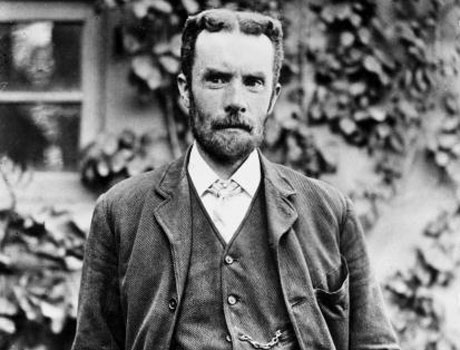Oliver Heaviside: Difference between revisions
No edit summary |
No edit summary |
||
| Line 59: | Line 59: | ||
Geselowitz, M. (2013). Did You Know? Someone Else Wrote Maxwell's Equations. Retrieved from The Institute: The IEEE News Source website: http://theinstitute.ieee.org/technology-focus/technology-history/did-you-know-someone-else-wrote-maxwells- | Geselowitz, M. (2013). Did You Know? Someone Else Wrote Maxwell's Equations. Retrieved from The Institute: The IEEE News Source website: http://theinstitute.ieee.org/technology-focus/technology-history/did-you-know-someone-else-wrote-maxwells- | ||
Hunt, B. J. (2012). Oliver Heaviside: A first-rate oddity. Physics Today, 65(11), 48-54. doi:doi:http://dx.doi.org/10.1063/PT.3.1788 | |||
Category: [[Notable Scientists]] | Category: [[Notable Scientists]] | ||
Revision as of 13:56, 2 December 2015
Page in progress and claimed by Lee Martin Frazer.
State, in your own words, the main idea for this topic
Oliver Heaviside (18 May 1850 – 3 February 1925)
Biography
Oliver Heaviside was born to poverty in 1850 in the London slum of Camden Town. Camden Town is the same slum distinguished author Charles Dickens was from. Heaviside was the child of water color artist and wood engraver Thomas Heaviside and Rachel West. At a young age Oliver contracted the scarlet fever which left him partially deaf. He was a top student in all subjects except geometry; however, by the age of 16 Heaviside had dropped out of school and began to teach himself.
Despite being born of little means, Heaviside was lucky because his maternal uncle by marriage was Charles Wheatstone. Wheatstone was a well-known inventor and electrical scientist who co-invented the telegraph among other accomplishments. Wheatstone took great interest in his nephews and was likely involved with Oliver’s first job as a telegraph operator.
Physics
Mathematics
How do we visualize or predict using this topic. Consider embedding some vpython code here Teach hands-on with GlowScript
Electrical Engineering
Be sure to show all steps in your solution and include diagrams whenever possible
See also
Further reading
- Heaviside, O. (2003). Electrical Papers: American Mathematical Society.
- Heaviside, O. (1950). Electromagnetic Theory. Oliver Heaviside. Complete and Unabridged Edition of Volume I... II and III with a Critical and Historical Introduction by Ernst Weber: Dover publications.
- Heaviside, O. (1892). On the Forces, Stresses, and Fluxes of Energy in the Electromagnetic Field: Harrison and Sons, Printers.
- Mahon, B. (2009). Oliver Heaviside: Maverick Mastermind of Electricity: Institution of Engineering and Technology.
- Nahin, P. J. (2002). Oliver Heaviside: The Life, Work, and Times of an Electrical Genius of the Victorian Age: Johns Hopkins University Press.
- Yavetz, I. (2011). From Obscurity to Enigma: The Work of Oliver Heaviside, 1872–1889: Birkhäuser Basel.
External links
- http://www.britannica.com/biography/Oliver-Heaviside
- http://www.aps.org/publications/apsnews/201002/physicshistory.cfm
- http://theinstitute.ieee.org/technology-focus/technology-history/did-you-know-someone-else-wrote-maxwells-equations
- http://www-gap.dcs.st-and.ac.uk/history/Biographies/Heaviside.html
- http://scitation.aip.org/content/aip/magazine/physicstoday/article/65/11/10.1063/PT.3.1788
- http://www.uh.edu/engines/epi426.htm
- http://www.theiet.org/resources/library/archives/biographies/heaviside.cfm
- https://archive.org/details/electricalpapers02heavrich
- https://archive.org/details/electromagnetict01heavrich
References
February 3,1925: Death of Oliver Heaviside. (2010). APS News, 19(2). Retrieved from http://www.aps.org/publications/apsnews/201002/physicshistory.cfm
Geselowitz, M. (2013). Did You Know? Someone Else Wrote Maxwell's Equations. Retrieved from The Institute: The IEEE News Source website: http://theinstitute.ieee.org/technology-focus/technology-history/did-you-know-someone-else-wrote-maxwells-
Hunt, B. J. (2012). Oliver Heaviside: A first-rate oddity. Physics Today, 65(11), 48-54. doi:doi:http://dx.doi.org/10.1063/PT.3.1788
Category: Notable Scientists
